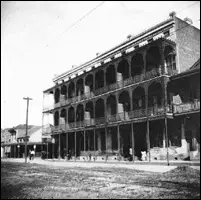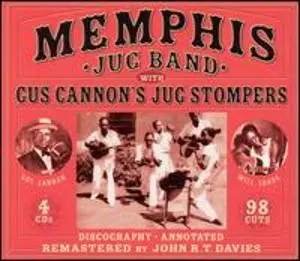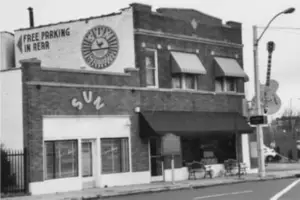MEMPHIS

Memphis gave birth to Rock’n’roll in the 50’s and in the 70’s it was known as Soulsville USA, but before WWII, Memphis was the centre of the Blues world. Situated on the Mississippi river, just above the Delta, it was a port and a railhead as well as a rich cotton town, which made it a thriving cultural crossroads. In 1909 W C Handy composed a campaign song for the Mayoral candidate EH ‘Boss’ Crump, and when he published it as ‘Memphis Blues’ in 1912 it marked the birth of an industry.
The first Blues song, ‘Memphis Blues’ as played by WC Handy’s band;
When the US Government closed down Storyville, the red-light district of New Orleans, in 1917 many of its residents relocated upriver to Memphis. Gambling, prostitution, bootlegging, music and a good deal of violence could be found in the neighbourhood of Beale Street. Clubs like Pee-Wee’s Place, the New Daisy and The Monarch bounced to the sound of barrelhouse pianos, ragtime banjos, up-tempo blues and jug bands, as people danced the night away.
 Gus Cannon‘s Jug Band was the biggest thing in Memphis in 1928 with their hit record ‘Walk Right In’. Jug bands played a style of good-time ‘hokum’ music, with harmonicas, violins, banjos, washboards, spoons and jugs. Cannon learned to play banjo in Clarksdale, often using a bottleneck style, and his harmonica player Noah Lewis was a terrific stylist, sometimes playing two harps at once. When the jug-band craze ended, Lewis joined up with Sleepy John Estes to tour the Delta juke-joints. Another outstanding talent of the time was the humorous songwriter and unconventional guitarist Furry Lewis. He lost a leg in a railroad accident, and came to prominence again in the Folk/Blues revival of the 50s, when he told his tall tales on TV chat shows and in Playboy magazine. Memphis Minnie was another rousing performer, making a big hit in 1929 with ‘Bumble Bee’. She went on to record over 100 tracks in the next two decades, including the outrageous ‘Me and My Chauffeur Blues’ and she became a major figure on the Chicago scene.
Gus Cannon‘s Jug Band was the biggest thing in Memphis in 1928 with their hit record ‘Walk Right In’. Jug bands played a style of good-time ‘hokum’ music, with harmonicas, violins, banjos, washboards, spoons and jugs. Cannon learned to play banjo in Clarksdale, often using a bottleneck style, and his harmonica player Noah Lewis was a terrific stylist, sometimes playing two harps at once. When the jug-band craze ended, Lewis joined up with Sleepy John Estes to tour the Delta juke-joints. Another outstanding talent of the time was the humorous songwriter and unconventional guitarist Furry Lewis. He lost a leg in a railroad accident, and came to prominence again in the Folk/Blues revival of the 50s, when he told his tall tales on TV chat shows and in Playboy magazine. Memphis Minnie was another rousing performer, making a big hit in 1929 with ‘Bumble Bee’. She went on to record over 100 tracks in the next two decades, including the outrageous ‘Me and My Chauffeur Blues’ and she became a major figure on the Chicago scene.
The proximity of the Delta just to the south meant there was a constant flow of country Blues players drifting through the town in the 20’s and 30’s. Riverboat connections with St. Louis and New Orleans meant that Jazz influences added to the cocktail of night-life on offer in the wild free-for-all of this ‘wide-open’ town.
 They say that in July 1954 ‘the Blues Had a Baby’. A hillbilly band were messing around at the end of a session at Sun Studios, and they broke into a version of Arthur ‘Big Boy’ Crudup‘s ‘That’s Alright Mama’. The singer was Elvis Presley and Sam Phillips knew instantly that the young man was going to be a big star. Sun Studios quickly became the centre of Rock’n’roll and Rockabilly music, with a stable of big-selling artists like Jerry Lee Lewis, Carl Perkins, Charlie Rich and Johnny Cash.
They say that in July 1954 ‘the Blues Had a Baby’. A hillbilly band were messing around at the end of a session at Sun Studios, and they broke into a version of Arthur ‘Big Boy’ Crudup‘s ‘That’s Alright Mama’. The singer was Elvis Presley and Sam Phillips knew instantly that the young man was going to be a big star. Sun Studios quickly became the centre of Rock’n’roll and Rockabilly music, with a stable of big-selling artists like Jerry Lee Lewis, Carl Perkins, Charlie Rich and Johnny Cash.
In the 70’s the phenomenon of the Stax record label gave us the talents of Wilson Pickett, Sam and Dave, a revitalised Rufus Thomas, the phenomenal Otis Redding and many more. The house band Booker T. and the MGs, backed all these great Soul singers, and also recorded with Blues stars Albert King, and ‘Pops’ Staples who both made scintillating albums for Stax, but the massive billboard outside the studio announced that this was ‘Soulsville USA’ and the records they made took Soul all over the world. The death of Otis Redding in an air-crash in 1967 and the assassination of Dr. Martin Luther King at the nearby Lorraine Motel the following year took the heart out of the company, and when their distribution deal with Atlantic records ended, they began to fail.
In the postwar era, the Blues shifted its centre if gravity north to Chicago, but for about 30 years Memphis was the undisputed Home of the Blues.
The unexpected sound of Stax in the 60s.